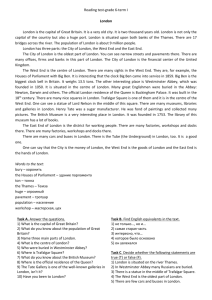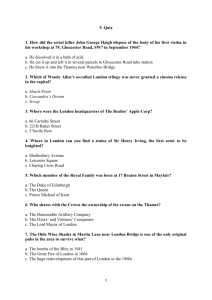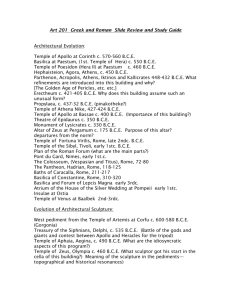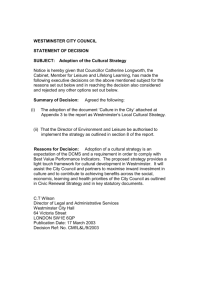Westminster Abbey is on the site of a former Temple of Apollo
advertisement
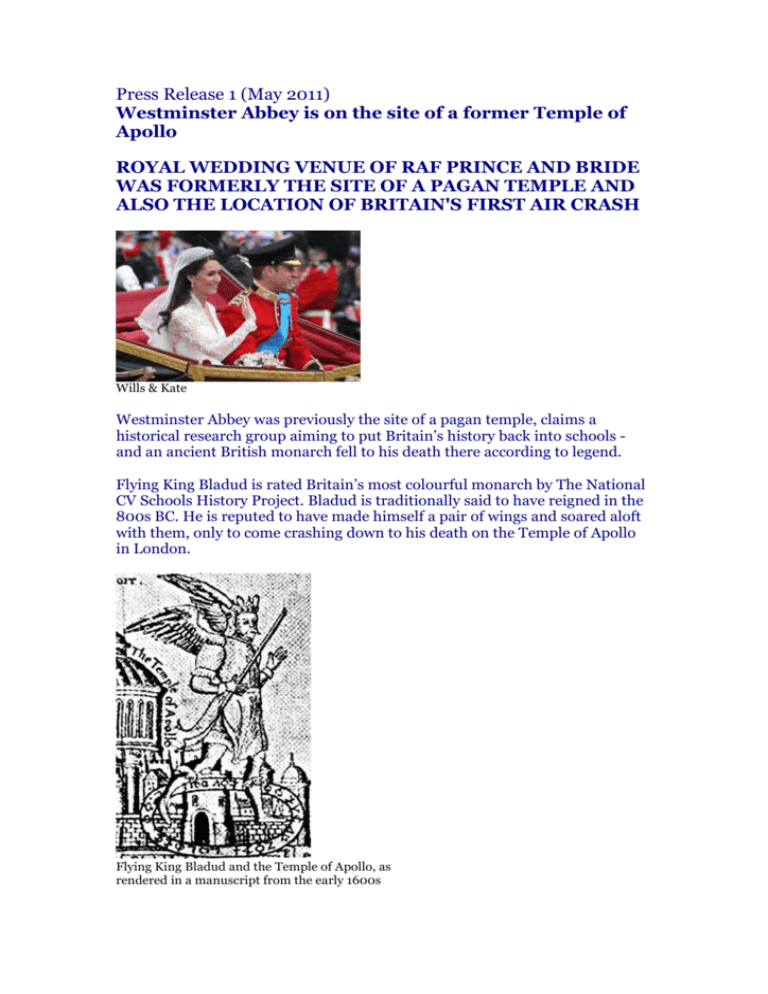
Press Release 1 (May 2011) Westminster Abbey is on the site of a former Temple of Apollo ROYAL WEDDING VENUE OF RAF PRINCE AND BRIDE WAS FORMERLY THE SITE OF A PAGAN TEMPLE AND ALSO THE LOCATION OF BRITAIN'S FIRST AIR CRASH Wills & Kate Westminster Abbey was previously the site of a pagan temple, claims a historical research group aiming to put Britain’s history back into schools and an ancient British monarch fell to his death there according to legend. Flying King Bladud is rated Britain’s most colourful monarch by The National CV Schools History Project. Bladud is traditionally said to have reigned in the 800s BC. He is reputed to have made himself a pair of wings and soared aloft with them, only to come crashing down to his death on the Temple of Apollo in London. Flying King Bladud and the Temple of Apollo, as rendered in a manuscript from the early 1600s “We don’t have access to King Bladud’s black box flight recorder,” explains John Hart, the director of The National CV Group, “so we decided instead to look into the possibility of their having been a Temple of Apollo in London. We found that one is reckoned to have existed on what is now the site of Westminster Abbey – the venue for the Royal Wedding no less.” Another member of The National CV Group is London historian John Chaple. He noticed something on a map by the Tudor cartographer John Speed (15521629). Under the heading ‘SAINT PAULES’ an inscription indicated that St Paul’s Cathedral was thought to have previously been the site of a temple to the goddess Diana. This claim is mentioned by the tour guides at St Paul’s. Illustration on John Speed's map of Tudor London Less familiar was the statement on the map under ‘St Peter’s’. That was a reference to Westminster Abbey, whose full title is now the Collegiate Church of St Peter, Westminster. The inscription referred to ‘Sulcardus’, who around AD 1080 was the first-ever historian to the church, and reads: ‘The church of Westminster was anciently the temple of Apollo as sayeth Sulcardus, which by an earthquake in the reign of Antoninus Pius was overthrown.’ Antoninus Pius was Roman Emperor in the period AD 138-161. His father was Hadrian of Wall fame and Antoninus himself gave his name to the Antonine Wall to the north of it. Early in its history the Abbey became known as the West Minster, while St Paul’s Cathedral was known as the East Minster. A minster is a church connected to a monastery. At the time of Henry VIII’s Dissolution of the Monasteries the Abbot of Westminster was John Feckenham (c1515-1584). He was to be the last such. Feckenham pleaded before the House of Commons in 1555, citing “…the Temple that then stood here at Westminster dedicated to the idol Apollo...”. The Abbey became a church headed by a Dean. “The early Christians chose existing sacred sites for their churches,” observes Dr Hart, “so it would be unsurprising if there was a pagan forerunner to Westminster Abbey. Note that in Greek mythology Apollo’s wife was Diana, Apollo symbolizing the Sun, Diana the moon. We still start the week on Moonday and culminate it on Sun-day. What this means is that in the pre-Christian era London had his ‘n’ hers pagan temples. These were superseded by his ‘n’ his churches: St Paul’s Cathedral and St Peter’s at Westminster. Wills and Kate might like to ponder this rich history as they tie the knot.’ The National CV Group have produced a new version of Britain’s story in the form of a personal history, which is scrupulously researched yet lively. So that is ‘Name: Britain’, ‘Age: 8000 years an island’ and so on. CVs are usually presented in the context of getting a job, but since nations can’t do that The National CV Group have Britain ‘Applying for the Future’. This is thus a forward-looking history for everyone in the UK, the people of these islands being identified in historical terms as the ‘Influential Islanders’. Britain was the birthplace of modern science, the industrial revolution and parliamentary democracy, amongst much else besides. A presentation based on The National CV has been trialled with success at twelve schools, to hundreds of pupils in the age range 9-14. Britain’s entire history is covered in an hour at a rate of more than a century a minute. Sponsorship is sought by the cash-strapped group to enable them to roll out the presentation for free across the nation’s schools. What of Flying King Bladud and the location of his legendary fall? How plausible is a Temple of Apollo, before the Romans? Comments John Chaple: “The Greek traveller Pytheas of Massalia famously visited Britain in the period 350-300 BC, long before the Romans. He describes a spherical temple of Apollo, which may well have been London’s.” The National CV Group note that King Bladud has an impressive CV of his own. By tradition he was a recovered leper and founder of the baths at Bath where the hot spring waters are said to have cured him of his youthful leprosy and that of his similarly afflicted pigs - and founder of the city of Bath itself. Bladud is also reputed to have been an enchanter and necromancer (communicator with the dead), father of Shakespeare’s King Lear (who swears “By Apollo” and is reminded by the person he’s speaking to that he appeals to the gods in vain; Act I, Scene i) and, as we have seen, ill-fated aviator. “The fabled King Bladud was Britain’s first recorded aviation fatality,” says Dr Hart. “He was Britain’s very own Daedalus and his doomed son Icarus rolled into one, as Bladud is said to have done the lot - designing, flying and dying.” Adds Dr Hart’s colleague John Chaple: “Wills is in the RAF of course but given King Bladud’s performance as an airman let’s not treat Bladud as the patron saint of flight but instead, as the founder of the baths at Bath and of the British bathtime.” [ENDS] Statue of King Bladud at the Roman Baths, Bath. Image courtesy of Wikimedia Commons A panel below the statue reads: BLADUD SON OF LUDHUDIBRAS EIGHTH KING OF THE BRITANS FROM BRUTE, A GREAT PHILOSOPHER AND MATHEMATICIAN BRED AT ATHENS AND RECORDED THE FIRST DISCOVERER AND FOUNDER OF THESE BATHS EIGHT HUNDRED SIXTY THREE YEARS BEFORE CHRIST. THAT IS TWO THOUSAND FIVE HUNDRED SIXTY TWO YEARS TO THE PRESENT YEAR 1699 Note 1. More on the Temple of Apollo at Westminster A number of early writers convey the tradition that there was a Temple of Apollo on the site of the modern-day Westminster Abbey. Here is a relatively late example of such writing in the form of a quotation from Speculum Britanniae: Historical and Chorographical Description of Middlesex and Hertfordshire by John Norden (London, 1723, page 42): ‘Master Camden from Sulcardus reporteth that there was first a Temple in that place [Westminster/Thorney Island], dedicate to Apollo which was overthrown by an earth quake in the time of Antonius Pius. It is not unlike that such an Idol Temple was, for it is reputed by ancient Authors, that the Troynovants, or Trinobantes, did sometime sacrifice Buls, Bullockes, Stags, and suchlike to Diana Tauropolia whom the Gentiles called the Queen of Heaven. Of the ruyns of that Idoll Temple, it is said that SERBERTUS King of the east Saxons, erected another Temple for the service of the living God, and consecrated the same to S. Peter, about the year of Christ 610. neer about the time of the building of Paules… I have heard that there are, or have been, records in the same Abbey, which declare that it was a Church before the Britons received the faith of Christ, which should seem to be that Idoll Church of Apollo before LVCIVS.’ Note that ‘LVCIVS’ is a reference to Lucius, son of Old King Cole of nursery rhyme fame. Cole reigned for 60 years from AD 95-154, as a Roman client king. It was during his time that the Temple of Apollo at Westminster was destroyed by an earthquake. Presumably this occurrence will have been treated as a sign of heavenly displeasure. In any event, Lucius, who reigned AD 155-180/1, became the first Christian king of Britain. He is mentioned by the Venerable Bede and Lucius’s letters to the Pope were said to be still extant in the Vatican Library in the seventh century - and may be there still. The last-ever Abbot of Westminster Abbey, John Feckenham (c1515-1584), made a statement to the nearby House of Commons at the time of Henry VIII’s Dissolution of the Monasteries. Here is part of what Feckenham said: “And first for the antiquity of Sanctuary at Westminster. It may please you to have consideration, how it is no less than 1,400 years since Sanctuary was there first ordained; for Lucius, the first Christian King of this realm (who, about 100 years from Christ, received the Christian faith from the holy Pope of Rome and martyr Eleutherius, by the ministry of the holy monk Fagan, who some call Fagan and Damian), immediately after that he was by the said holy monk baptized and instructed in the true profession of Christ’s religion, did destroy the Temple that then stood here at Westminster dedicated to the idol Apollo, and in place thereof erected a new Temple to the honour of the True God, our Saviour Jesus Christ, and of St. Peter, from whose sanctity he received the benefits of Christianity; and there he, by his free grant, ordained Sanctuary.” This is a quotation from Arthur Penrhyn Stanley’s Historical Memorials of Westminster Abbey, 1868, pp611-612. It discloses that Lucius was the founder of the first Christian church at Westminster. Note 2. More on King Bladud of Britain Here is the entry for Bladud from John Milton’s The History of Britain (1670, pp14-15): ‘Bladud, his son, built Caerbadus, or Bath, and those medicinal waters he dedicated to Minerva; in whose temple there he kept fire continually burning. He was a man of great invention, and taught necromancy; till having made him wings to fly, he fell-down upon the temple of Apollo in Trinovant [London], and so died after twenty years reign’. Bladud is mentioned in the Tysilio Chronicle (Jesus College MS LXI, Bodleian Library, Oxford; translation by Dr Wm R Cooper, 2002). The original version of this document was composed in the AD 600s by a monk called Tysilio. Here is what the Tysilio Chronicle has to say about Bladud (p13): ‘And after Hudibras came Bladud, his son, who ruled for twenty years. And he built Bath and the springs that were perpetually warm for any that had need of healing. And he worshipped the goddess Minerva. He learned the use of coals which burn to fine ash, but which flare up a second time into balls of fire… And Bladud was a deep and cunning man, the first in all Britain to talk with the dead. And he did not cease from doing such things until he had made for himself pinions and wings and flew high in the air, from where he fell to earth onto the Temple of Apollo in London, and was broken into a hundred pieces.’ The translator adds this in a footnote on the same page: ‘…a Roman votive coin was found in a spring at Bath, an engraving of which appears in Campden’s Britannica (see Manley Pope, p.168). On the obverse is a winged head and the inscription Vlatos (Bladud), and on the reverse a unicorn with the legend Atevia, meaning a gift or vow. This dates the tradition to Roman times at the latest, when it is safe to assume that it was already very old.’ Dr Cooper then goes on to refer in the same footnote to the Mediterranean island of Levkas, where: ‘…there are the remains of a temple to the sun god Apollo (who in Greek mythology was the husband of Diana). These ruins lie on a prominence some 230 feet above the sea, and: “…it was from here that the priests of Apollo would hurl themselves into space, buoyed up – so it was said – by live birds and feathered wings. The relationship between the ritual and the god seems obscure, although there was an early connection between Apollo and various birds….Ovid confirms that the virtue of the flight and the healing waters below the cliff had been known since the time of Deucalion, the Greek Noah.” (Bradford, E, Companion Guide to the Greek Islands, Collins, London, 1963, p. 48). Bladud, it is recorded, also made himself pinions and wings and with them attempted to fly. But the intriguing detail is that he fell onto the temple of Apollo which stood in Troinovantum, present-day London.’ Geoffrey of Monmouth (c1100-c1155) mentions Bladud (History of the Kings of Britain, Chapter X) as contemporaneous with the Prophet Elijah in Israel. This would place Bladud in the ninth century (i.e. 800s BC). Bladud is also mentioned by the French chronicler Jehan de Wavrin (c1400-c1474), who wrote a history of Britain, Recueil des croniques et anchiennes istories de la Grant Bretaigne. Remarkably, De Wavrin was an observer on the French side at the Battle of Agincourt (1415), in which his brother and father fought and died. De Wavrin refers to Bladud as a contemporary of Romulus, the legendary founder of Rome. This would place Bladud in the eighth century (i.e. 700s BC). Near to Westminster Abbey was Tothill Fields, anciently London’s recreation ground. If one were to make a test flight, this would have been as good a place as any to choose. Contacts: John Hart Email: info@thenationalcv.org.uk John Chaple www.johnchaple.co.uk
